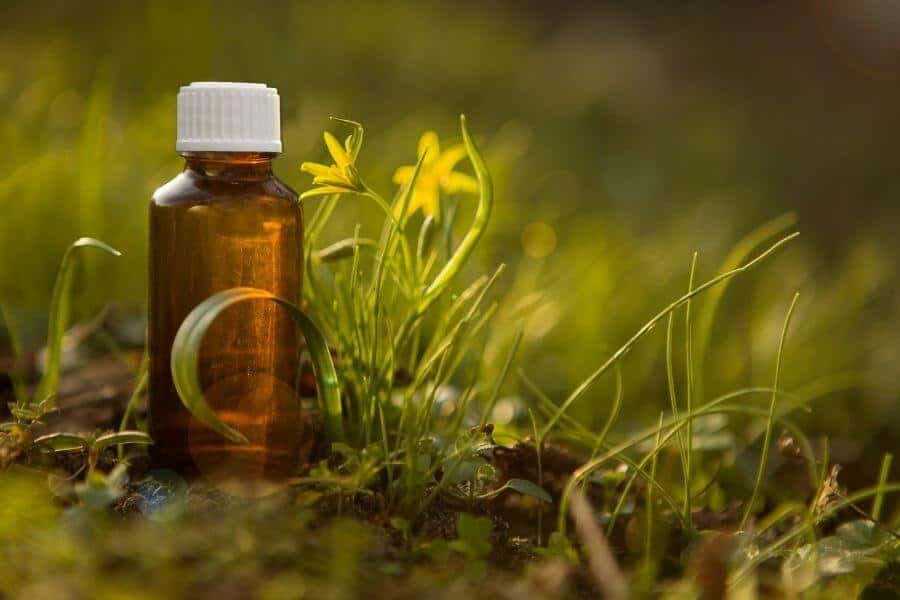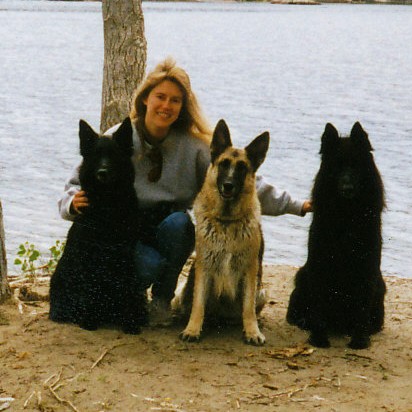Wondering if flower essence therapy is right for your dog (cat, horse or other pet)? If you’d like to know what to expect before giving them a try, this article is for you.
About 25 years ago, I was where you are now. I’d heard of flower essences – read about them in a popular book at the time on natural health for pets -Â but I didn’t know enough to even decide to try them.
What exactly do they do? Will my dog act weird or “out of it” on them? Is this something they will need forever? What if I don’t choose the right ones?
Maybe flower essences have popped up in an online search while researching how to solve a dog behavior problem. Maybe your dog trainer or holistic veterinarian recommended them. Maybe you’ve heard talk at the dog show or agility trial.
However you got here, I’m going to try to answer those “what about…?” questions that you and a lot of people have, and that I had at one point, too.
I know I count myself very fortunate to have found these amazing natural remedies, and I would love to help you get success with them, too.
Are flower essences calming?
Flower essences balance. If an animal is in any sort of extreme or unbalanced emotional state, flower essences will exert a stabilizing influence, a sort of ideal pattern of what the emotion should look like.
In highly stressed animals, this may indeed take the form of calming. In less stressed animals, and in animals with deeper or more subtle imbalances, the effect of flower essences may only produce a shift in behavioral responses in particular situations (where it has been erratic, uneven, or extreme).
In cases where the animal lacks confidence, hopefulness, or interest in day to day life, flower essences may well be energizing.
So, my best answer is that flower essences will be calming, if calm is a natural result of a more balanced emotional state.
How long do flower essences take to work?
How quickly flower essences work with an animal’s behavior problem will depend on the animal, the severity of the problem, and how long it’s being going on. It will also be affected by the dog’s environment and stresses, other supportive factors, and often, the animal’s relationship to those around it.
But to be very general, flower essences can work in minutes to produce an initial perspective shift, or they may take anywhere from a few days to several weeks before observable changes have taken place.
I say “observableâ€, because Bach flowers work to balance energetically, under the surface. It can take time for energetic balancing to show outwardly, on the surface of actual behavioral response.
Further, it really does seem to vary according to the animal. Some seem more tuned in to the subtle balancing effect than others. Also, highly stressed or out-of-balance animals often respond quite quickly with at least an initial calming or shift in attitude, even when there is more “under the surface†work to come.
It’s important to remember that flower essences aren’t drugs. When asking how quickly they work, it’s not a matter of asking how long it takes the system to be saturated by the medication. It’s somewhat like asking how long it takes a vacation or a walk in nature to “fix†stress or a bad attitude. “It depends†is really a pretty good answer.
What does animal behavior improvement look like with flower essences?

If the essences chosen are appropriate, there will be a period of subtle energy shifts taking place under the surface of visible, everyday behavior.
In highly stressed dogs, it’s not uncommon to see “softer” eyes, and softer, less tense, more fluid body language, sometimes within minutes of giving the formula. The dog may even lie down and go into a deep sleep.
This is not due to any sedative effect but is, I believe, a response to the lifting of severe stress, which allows for relaxation in what is typically a very stressful situation for the dog.
While this does not necessarily happen every time, when it does occur, I consider this a solid indicator that further positive changes are in store.
Often, though, there will be no striking change in behavior for the first day or two, sometimes much longer (as long as a few weeks).
The types of early changes on flower essences can best be described as shifts in perspective. That is, how the animal perceives certain situations will change. It’s this perception shift that ends up becoming a behavior change.
In most cases, you will start by seeing a more balanced, even-keeled reaction in situations that normally trigger a negative or extreme response in your dog. Frequently, the reaction you’ve come to expect simply doesn’t happen or, if it does occur, it’s not as intense or long-lasting as you’re used to.
As you might expect, early behavioral progress tends to be in areas that are less stressful or habitual for the dog, with improvement in more difficult situations building over time.
Once again assuming the appropriate combination of essences has been chosen, you should expect to see a gradual but progressive reduction in intensity, frequency, duration, and/or tenacity of the negative reaction.
Does progress always move in a straight line? No.
If you picture progress as a line on a graph, the line of improvement is not perfectly straight. The general trend is upward, but the actual events may go above the line some days, below it the next. The important thing is that over time, the line is moving overall toward improvement.
When working with flower essences with your dog or other animal, try to keep the big picture in mind, and not take the occasional dips and setbacks to heart.
Finally, with flower essences it’s important that your expectations be realistic. Avoid looking for ultra-specific outcomes. Look for – and take advantage of – early signs of improvement, and use those as stepping stones to teach the more specific outcomes you’re looking for.
How long does the effect of Rescue Remedy and other essences last?

I think it’s fair to say the initial effect is short term (as in hours), but as the animal becomes more balanced, the effect holds for longer and longer.
It’s impossible to say exactly how long the effect of a dose of flower essences (including Rescue Remedy) will last. It’s kind of like asking how long a massage or chiropractic adjustment will last. It will depend on the individual’s tendencies, their environment and whether it supports healthy reactions, overall stress levels, emotional challenges, etc.
Once the animal has adjusted to the new balance, assuming life doesn’t keep forcing her back off balance, the effect can be long term or permanent.
What’s the best way to support behavior improvement with flower essences?
It’s always helpful to remember that flower essences are a tool that should be used within an entire holistic framework. With animals, like with humans, we should try to support the formation of new and better responses to stress and difficult situations and events.Â
Below, I outline a few ways to support your pet as they change and improve with flower essences.
Reinforce improved reactions

The quickest and most obvious way to support your dog’s improved responses on flower essences is to reinforce them.
Let your dog know, in the very moment they behave even slightly better, that you appreciate them. This can be as simple (and portable) as a smile, a kind word, a soft stroke on the shoulder. If you’re prepared, it can be a click and a treat (or just a treat), or a favorite game or activity.
However you choose to reinforce your dog’s good better behavior, the point is that you will do well to let him know you appreciate it. Taking an active role like this will help speed the process along and help solidify the new, more balanced reactions.
Avoid putting your dog into situations he can’t handle. By allowing him to stay within his comfort zone, his overall confidence and capability will increase naturally, at which time you can increase your expectations. Building a dog’s confidence in new behavior takes time. Just do it gradually, and at your dog’s pace. When you ask him to do more than what he’s used to, always evaluate how he did and what you need to take into account next time to help make sure he can be successful.
Remember that training a reactive or aggressive animal is not optional. With any kind of serious behavior issue, flower essences should be considered a tool to support training (meaning that training is indispensable). If your dog is threatening or behaving in a way that scares you or others, seek the help of a qualified professional dog trainer, behavior consultant or veterinary behaviorist – period.
To learn more about this, be sure to check out my article, Flower Essences for Dogs: Tips for Success
Do a “wellness check†for your dog’s behavioral health
- Is your dog healthy? Is he physically sound with no unaddressed pain or discomfort that could contribute to poor reactions or attitude? Behavior problems can be a sign of something physically wrong. It’s crucial to consult your veterinarian regularly, and especially if you notice any sudden or dramatic change in behavior.
- Does your dog get enough downtime and quiet time? Does he get a chance to burn off excess tension and energy?
- Is his diet one that supports a healthy energy level and attitude?
- Are there environmental stressors that can be reduced or eliminated? Are there ways to help your dog cope with the ones you can’t eliminate?
How long will my dog (cat, horse, bird) need flower essences?
For acute situations, like thunderstorms, fireworks, etc., that come on suddenly and only lasts a short time, flower essences are given until the animal gets relief. So, in this kind of situation, flower essence use is very short-term.
For long-term patterns of behavior, extreme trauma, etc., expect flower essences to continue to work to balance your dog energetically for some time (weeks or months). The only solid rule is to keep your dog on the essences for as long as you continue to see regular progress.
The time frame for this is highly individual, and depends on the dog, the behavior, and any day-to-day stresses that may cause the dog to be more prone to imbalance.
Is there a best way to switch flower essence blends or stop altogether?
To start off with, let me say I always suggest leaving a little of the successful blend in reserve, if you plan to stop using it (either altogether or by changing to a different blend). This is because it’s not uncommon to discover the blend is helping more than you realized. (This is more important if you’re using a service to blend the formula, rather than mixing your own flower essences at home.)
That said, if you saw no noticeable improvement, or if the improvements that did happen have leveled out and the new, better behavior seems stable, then you can start to give the formula less frequently each day. I like to start with dropping one dose per day.
Give it a few days at the new frequency, then evaluate how things are going. If your dog’s behavior seems just the same, you can try dropping a second dose per day. Give that a few days, re-evaluate, then if all is well, go ahead and reduce by yet another dose per day.
Often, once the emotions (and therefore behavior) are stabilized, you can stop giving the flower essence blend completely, although I recommend keeping some on hand to use prior to any life situations that tended to bring on the less-balanced behavior or reaction.
If your dog is periodically going into that kind of situation, it’s always a good idea to go back to giving the essences for a day or two (at 3 or 4 times per day) before that stressful or “triggering†event. This seems to be enough to refresh the effect in stressful situations.
Do I need to wean my dog off flower essences?
In general, it’s best to reduce the number of doses per day gradually. This isn’t weaning off per se, because there is no “withdrawal†effect from flower essences. It’s not unusual at all, however, to discover, upon backing off the doses, that they were still having a subtle balancing effect. And it’s better to discover that gradually than suddenly.
The one instance I would say doesn’t follow this, is when the animal tells you they don’t need the flower essences anymore. I have found that certain animals are very aware of the energetic need for flower essences.
If it has been responding well and its behavior improving, then one day she suddenly rejects taking the essences, that may be a sign she has gotten the benefit she needed from that particular remedy or combination.
Do flower essences have side effects?
Flower essences do not have side effects. This is one of the things that makes them so appealing. Flower essences balance emotions.
If your animal doesn’t lack balance in a certain emotional area, then the corresponding flower essence won’t do anything, because there is nothing to balance.
Will flower essences change my dog’s personality?

Flower essences only balance out-of-balance emotional states. If your dog has been out-of-balance for a long time, I suppose it’s possible that returning to a more balanced state may seem like a personality change.
But while flower essences can change attitude and behavior, it will never happen in a way that’s not natural for that animal.
They will simply help him respond and react in ways that are more well-adjusted while in keeping with his particular temperament.
What if I pick the wrong flower essences?
Choosing the wrong flower essence(s) won’t cause any harm or strange reactions. It simply will have no effect.
My only caution (of sorts) would be to make sure you give flower essences enough time to work before evaluating if they were effective or not. This can be as long as a month.
And if your first choice of flower essences truly didn’t work, try another combination. Be willing to consider that your determination of what your animal is feeling wasn’t quite spot-on.
Even for experienced flower essence users, interpreting emotional motivation for an animal’s behavior is not a simple, cut-and-dried process. It can take some experimentation to find the perfect essences for a particular animal.
Why did my dog’s flower essence blend stop working?
Flower essences don’t typically stop working without cause.
If the flower essences you were using on your dog seem to have stopped working, ask yourself:
Did I reduce the frequency of doses? If you had dropped back on the number of doses and at some point later the essences seem less effective, try going back to four times per day, or at least three.
Have I been consistent giving the doses? Consistency is really important when using flower essences. If you’re having trouble being consistent, put the bottle somewhere you will see it many times daily. (I leave my flower essence bottles on the counter next to my dogs’ food supplements they get at every meal. Hard to miss!). Also consider keeping a second near your favorite chair, or in your purse or training bag, in your car, at the training facility, etc.
Did the bottle contents get contaminated? Flower essences are very delicate, as you might imagine. If foreign materials are introduced into a dosage bottle (say, the dropper fell on the floor or you touched it by accident to the animal’s mouth, etc.), it may actually interfere with how well the essences work. If you think this may have happened, replace the formula with a freshly made one.
Did the flower essence bottle get exposed to harmful energy? I’ve never had this happen myself, but I’m also very careful never to put a flower essence bottle in my purse next to my cell phone, for instance. I also avoid any close contact to CPUs or any device that puts out constant energy. This can disrupt the energy of the essences and make the formula useless. Again, if this may have happened, the only solution is to get or make a freshly blended bottle.
Have the emotions behind the behavior changed? In flower essences, there is something known as an onion peel (or peeling the onion) effect. Emotions in all animals are often layered, one upon another.
When we choose flower essences to address a particular behavior and its emotions, we go by what we’re aware of; what we can see on the surface. It can happen that there are underlying, less obvious (or completely hidden) emotions driving poor behavior. When a blend addresses the “surface†emotions, it may uncover deeper emotions that were unseen and unexpected.
In that case, the flower essences need to be adjusted to reflect the emotions now visible on the surface. (So, re-evaluate your dog periodically to make sure the blend he’s on actually addresses his current emotions, not the ones he was experiencing when he started the flower essences, since those may have changed.)
What if the flower essences I picked seem right, but didn’t work?
Sometimes we put a ton of thought into selecting essences, but still get no results. This is understandably frustrating. Usually, though, there is some reason for the fail.
What follows are some possibilities to consider if flower essences didn’t seem to work for your dog, cat, horse, bird (etc.!):
For a very thorough look at how to select Bach flower essences for dogs, be sure to take a look at my article, How to Select Bach Flower Essences for Dogs
Wrong choice of essences. I know, you just said you were pretty darned sure the essences were spot-on! The thing is, many people think that, only to discover afterwards they were not quite on base. The two most common reasons I see for this are misunderstanding of basic dog behavior (i.e. not reading the dog accurately, making assumptions about the behavior) and over-thinking what the underlying emotion is, rather than addressing what you see.
The first instance happens often with pet owners and those who are not experts in animal behavior. They’ve been taught to believe this behavior means that motivation, when it tends to be more complex than that. Let’s say a dog lifts his leg in the house. Pet behavior “experts†may have you believing that this is dominance, plain and simple. And it might be. But it could also be insecurity, lack of control, a strong habit, etc.
With flower essences, it always pays to take a step back and look at the problem behavior unemotionally. If you’re not confident reading your dog’s body language in his problem situations, there are any number of great online guides to help you interpret how your dog is feeling by reading his body language.
The second is a mistake sometimes made by more experienced dog folks. They try to drill too deep into the dog’s motivation. A bossy, bully dog that is terrorizing his family is really “scared to lose respect and love and so acts out in order to prevent lossâ€. And so they give him something for lack of confidence and fear, instead of the domineering, bullying behavior.
Even if they’re right, that there is some deep Freudian dysfunction, this is not the way to choose flower essences. Go with what’s on the surface. If you’re right that underneath all that bluster (for instance) there is a scared little puppy, then it will show itself as the surface emotions get balanced and the excessive emotions gets cleared away.
Hasn’t been long enough. Certain changes take just longer. My experience in using Bach flower remedies with dog behavior, as well as using them personally for myself, has taught me that occasionally, for whatever reason, some shifts in perspective take longer to be worked through than others.
I have seen dramatic changes happen weeks after a formula was stopped, given up as having no effect. The responses seen were so dramatic, unexpected and out of character that it was highly unlikely to be attributable to anything other than the flower essence formula. So, I encourage you to keep track of responses, even weeks after stopping a formula. You may still be in for unexpected results.
Inconsistent use. Make sure you’re giving flower essences regularly. Inconsistent use usually gives inconsistent results. Sometimes it can help to switch methods of administration if you’re having trouble giving it one particular way. See my article on simple, effective ways to give flower essences to animals.
Not given frequently enough. Flower essences should be given three or four times every day. Yes, I see some that respond to twice a day. But many won’t. Some animals will need the higher number of doses for flower essences to be effective. Test out different frequencies and see what your dog responds to.
You’re too close to the problem. The fact is, some people are better than others at noticing the absence (or reduction) of behavior. Frankly, even for experienced observers of canine behavior, it is simply human nature to take greater note of what’s present than what’s not.
If you’re not sure if you are seeing results after at least two weeks on a particular formula, try asking a friend who is familiar with your dog if s/he notices any difference. I can’t say how many times people have initially reported they didn’t feel a formula was working, only to contact me later after friends spontaneously remarked how much better their dog seemed lately!
Another option is to stop giving the essences, and note if there is an increase in the frequency or intensity of the problem behavior. Sometimes this is how people discover the formula was actually working – by observing the increase in problem behavior when they stop giving the flower essence formula.
Expectations too specific or unrealistic. Remember that you’re looking for your dog’s problem behavior to gradually, progressively reduce as his emotions level out. Only being satisfied with ultra-specific outcomes is asking for failure. Instead, keep your expectations realistic and expect to help (i.e. train) your dog through his problem situations as his emotions get healthier and more even keeled.
Too much pressure from life stress driving the problem behavior. While flower essences can do a lot, they can’t work miracles. If an animal’s life is such that ongoing stress continues to drive it off balance, then flower essences will make little or no lasting difference. Do what you can to ease the stress and give your dog a fighting chance to be more resilient and emotionally healthy, then try flower essences again (if you need to).
It’s not actually the dog. With animals, sometimes the human partner is not willing or ready to see that the problem lies less with the animal than with themselves. They want a “fix†for the animal, period. In those cases, things don’t tend to have much resolution. With flower essence therapy in dogs, the team has to become more balanced, not just the dog. So often, animals reflect our emotions and bounce them back to us. In these cases, the animal is not the only one that needs the flower essences!
Of course, in some cases, you will simply, truly see no changes because the essences had no effect. While it’s reasonable to assume there are some dogs that are resistant to the effects of flower essences, most often, when flower essences truly have no effect, it’s because the emotional source of the problem behavior wasn’t correctly identified.
I find this can actually be useful information, since if the motivation behind the behavior has been misunderstood, then any training approaches being taken to help resolve the problem behavior may also benefit from re-evaluation and possible adjustment.
Conclusion
Flower essence therapy for animals is growing by leaps and bounds in popularity. It seems like every day new pet owners, trainers, and health professionals are realizing the value of Bach flower and other essences.
Knowing what to expect, and how to support your pet’s behavior improvement can go a log way to making flower essence therapy for your dog, cat, horse, or bird a grand success.

Julie Cantrell BSc is a professional dog trainer and canine behavior consultant who’s logged many thousands of hours training dogs and teaching owners since 1990. Flower essences have been part of her work with canine behavior since 1994. (Bio)







